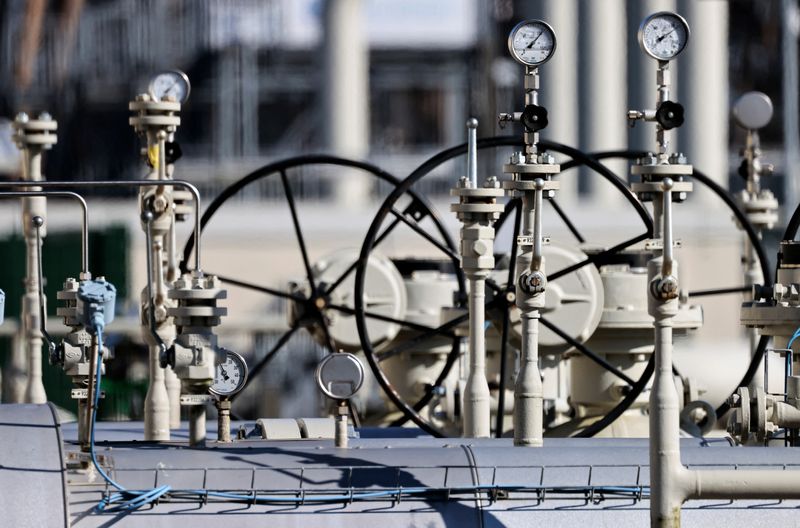By Nina Chestney
(Reuters) - European gas prices have risen further amid concerns about supply as Russia and the West remain at odds over Moscow's demand for gas payments to be made in roubles.
Last week, Russia said "unfriendly" countries must pay in roubles, not euros, for its gas in the wake of the United States and European allies teaming up on a series of sanctions aimed at Russia.
The Russian central bank, the government and Gazprom (MCX:GAZP), which accounts for 40% of European gas imports, should present their proposals for rouble gas payments to President Vladimir Putin by March 31.
Russia is ready for the possibility that Europe might stop buying Russian energy supplies, the TASS news agency quoted the speaker of Russia's upper house of parliament as saying.
HOW RELIANT IS EUROPE ON RUSSIAN GAS?
Europe depends on Russia for about 40% of its natural gas, with most transported by pipeline. Total Russian supplies to Europe last year were at around 155 billion cubic metres (bcm), with 52 bcm of that going via Ukraine or nearby routes.
Some pipelines transit Ukraine, while others take alternative routes, such as Yamal-Europe, which crosses Belarus and Poland to Germany, and Nord Stream 1, which runs under the Baltic Sea to Germany.
Most European countries have cut their reliance on Russian gas in recent years. In 2021, the Ukraine transit corridor was mainly used for gas going to Slovakia and then to Austria and Italy.
U.S. President Joe Biden has imposed a ban on Russian oil and other energy imports and Britain said it would phase out imports through the end of 2022.
The EU has said it wants to cut Russian gas by two-thirds this year and end its reliance on Russian supplies "well before 2030".
WHERE ELSE CAN EUROPE GET SUPPLY FROM?
Some countries have alternative supply options and Europe's gas network is linked up so supplies can be shared, although the global gas market was tight even before the Ukraine crisis.
Germany, Europe's biggest consumer of Russian gas which has halted certification of the new Nord Stream 2 gas pipeline from Russia because of the Ukraine crisis, could import gas from Britain, Denmark, Norway and the Netherlands via pipelines.
Germany's utility association BDEW has called on the government to come up with an emergency plan to prepare the country for disruptions to Russian gas supplies.
Norway's Equinor said it is considering ways to produce more gas from its Norwegian fields during the upcoming summer in Europe, a season in which output is normally affected by maintenance.
Southern Europe can receive Azeri gas via the Trans Adriatic Pipeline to Italy and the Trans-Anatolian Natural Gas Pipeline (TANAP) through Turkey.
The United States will work to supply 15 billion cubic metres of liquefied natural gas (LNG) to the European Union this year, the transatlantic partners said last week.
Senior U.S. administration officials did not specify what amount or percentage of the extra LNG supply would come from the United States.
U.S. LNG plants are producing at full capacity and analysts say most of any additional U.S. gas sent to Europe would have to come from exports that would have gone elsewhere.
Europe's LNG terminals also have limited capacity for extra imports, although some European countries say they are looking at ways to expand imports and storage.
ARE THERE OTHER OPTIONS TO COPE WITH A GAS SUPPLY CRUNCH?
Several nations could seek to fill any gap in energy supplies by turning to electricity imports via interconnectors from neighbouring states or by boosting power generation from nuclear, renewables, hydropower or coal.
The European Commission said gas and LNG from countries like the United States and Qatar could this year replace 60 billion cubic metres (bcm) of the gas Europe gets annually from Russia. By 2030, increased biomethane and hydrogen use could also help.
New wind and solar projects could replace 20 bcm of gas demand this year, while tripling capacity by 2030, adding 480 GW of wind and 420 GW of solar energy, could save 170 bcm a year.
Turning down thermostats by 1°C could save an extra 10 bcm this year, while by 2030, replacing gas boilers with 30 million heat pumps could save 35 bcm, the Commission added.
Nuclear availability is falling in Belgium, Britain, France and Germany as plants are facing outages as they age or are decommissioned or phased out.
Europe has been trying to shift away from coal to meet climate targets but some coal plants have been switched back on since mid-2021 because of surging gas prices.
Germany has said it could extend the life of coal or nuclear plants to cut reliance on Russian gas.
In past crises, countries have also sought to reduce industrial production at certain times, pay back-up generators to switch on supply, order households to curtail energy use or enforce temporary power cuts.
If Germany does not get enough gas to meet its needs it's the country's industry, which accounts a quarter of Germany's entire gas consumption, that would be hit first, analysts said.
HAS SUPPLY TO EUROPE BEEN DISRUPTED BEFORE?
The last 15 years have seen several disputes between Russia and Ukraine over gas, mostly to do with prices paid.

In 2006, Gazprom cut supplies to Ukraine for one day. In the winter of 2008/2009, Russian supply disruptions rippled across Europe. Russia cut off supplies to Kyiv in 2014 after Moscow annexed Crimea.
Ukraine stopped buying Russian gas in November 2015 and has instead imported gas from EU countries, by reversing the flow in some of its pipelines.